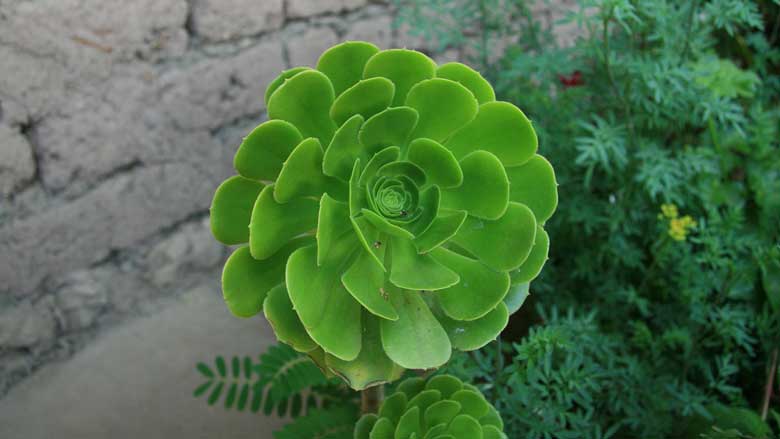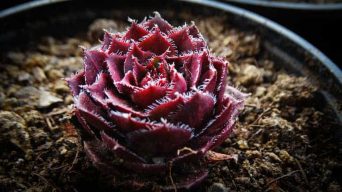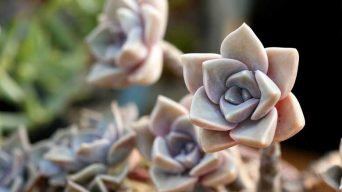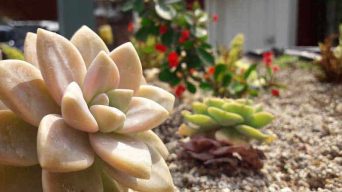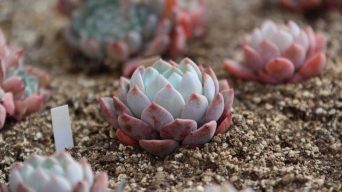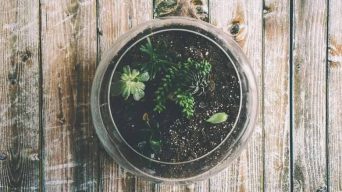Succulents are a type of plant known for how easy it is to take care of them. They can survive in dry, hot climates and require very little water.
Since they are so low maintenance, people often use succulents as decorations inside their homes or on the porch.
Succulents generally only grow a few inches tall, but how big do succulents get?
Many people would be surprised how large they can grow.
The average height of most types of succulents is between six inches and two feet tall, but some varieties, like the Elephant Bush or Jade Plant, can reach up to eight feet in height!
Knowing how big do succulents get is essential when choosing which types of plants to put in your home or garden so you don’t end up with a plant that will be too small for what you need.
Factors That Affect How Big Succulents Get
Several factors affect how big do succulents get.
The environment they grow in is the most important factor, but there are other things to consider.
The Size of the Pot
Succulents in smaller pots tend to be more sensitive. If they are over-watered, it can result in root rot and kill them quickly.
On the other hand, succulents that grow too large for their containers may stop growing due to their restricted roots from lack of space.
It is important not to move an already mature plant into a small container unless you want its growth pattern altered drastically or stopped altogether.
Good luck repotting your baby, though! Start with a larger pot if possible when beginning with a new variety to avoid any problems later on down the road.
Succulent lovers should consider handmade concrete planters, which work well for all sizes and types of succulents and can be made to fit almost any space.
Watering Schedule
Succulents don’t need much water, but how often they require it depends upon how dry or humid their environment is and where they are located in the home (i.e., a sunny window vs. shaded patio).
A good rule of thumb for watering is once every week or two, with some varieties requiring more frequent watering depending on how hot and dry the air gets indoors due to heating/cooling systems during different times of the year.
If your plants still appear moist after a couple of weeks without needing to be watered, then you may only have to wait another week before giving them a drink again because this means that your potting mix probably has a good amount of moisture left in it even if the plant itself is dry.
Light
A bright sunny window with a southern exposure works best for most succulents, but some can be acclimated to lower light conditions.
While succulents require sun, they also need protection from excessive heat and sunlight, which can kill them if left in direct (or even indirect) sunlight for too long each day.
If you are growing succulents indoors, it is important to rotate your plants regularly, so all sides receive light equally.
Temperature
Succulents are very easy to care for because they don’t need temperatures that drop below freezing, but how much fluctuation between day and night temps you can tolerate depends on the variety of succulent plants themselves as well as how large it has grown over time.
The bigger a succulent gets, the more likely it will survive cooler nighttime lows without any problems.
Smaller varieties may not fare as well with colder nights, especially if there isn’t an overhead lamp or some other heat source nearby.
If your home tends to get chilly at night during the winter months, then consider adding another grow light near where your plants reside to provide a bit of additional warmth.
Fertilizer
It is not necessary to fertilize most succulents because they are adapted well enough that their roots have access to all the nutrients required for growth provided by rainfall.
However, certain varieties may require it if they do not receive adequate amounts of water during drought periods, resulting in malnutrition over time, resulting in reduced health and slower growth rates.
Another option is to plant them close together or cover part of the soil with other plants, such as mosses, which take up extra nitrogen from the air around us as a natural additional nutrient source when available.
Soil
Succulents like cacti need soil that drains well, but how quickly it depends on the potting substrate you use.
A cactus mix is usually recommended for desert succulents. It has a coarse texture that allows water to drain without pooling too long underneath while remaining relatively dry between watering cycles overall.
If your plant needs more moisture than this, then you may want to select another option or repot them in different containers if possible.
It’s not good for succulents to sit in water for too long since it can cause them to rot from the roots upwards if their drainage holes aren’t large enough.
Repotting
Succulents don’t require much pot space, and how often you should repot depends on how quickly they outgrow each container.
If your plants seem cramped in their current planter, then it’s time to give them a larger one, even if they don’t appear too rootbound.
Remember that succulents are slow-growing plants, so how long this takes varies from plant to plant.
You don’t want to wait until roots start poking out of the drainage holes to repot them. However, if their roots are growing out of the bottom, you definitely should not wait any longer to move your succulents into a larger pot.
How Big Do Succulents Get?
Succulent plants may seem small when you first buy them, but how big do they get over time, and how long does it take?
Since succulents are slow-growing plants, how big they get depends on the type of succulents themselves and how much light, water, and nutrients are available.
Smaller varieties tend to remain small for a very long time, while bigger ones may eventually need repotting into something larger if you want to keep them around for a long time.
Big Succulents
Fortunately, how big do succulents get is not always limited by their pot.
If you are growing a large variety in the right conditions, it can continue to grow indefinitely! The following are some of the most common and popular big succulents:
Aloe Vera
The Aloe Vera is probably the most popular houseplant in the world, especially since it is so commonly used for its medicinal purposes.
Aloe vera naturally grows as a large plant but can be kept small if you would like by cutting off any of its leaves that grow too long.
It can grow up to three feet tall and two feet wide in optimal conditions.
Crassula Ovata (Jade Plant)
The jade plant is another popular big succulent, which makes it great for beginners looking to try out how to grow succulents at home or in the office without too much commitment!
When given enough sunlight, it flowers small white flowers and grows up to five feet tall in ideal conditions.
Aeonium Arboreum
The Aeonium arboreum is a beautiful succulent that looks like a tree.
It is a very slow-growing plant and will only grow about three feet tall, but its large leaves are beautiful.
Euphorbia Trigona (African Milk Tree)
Although it is technically an African tree, the Euphorbia trigona has adapted so well to container living that many people keep them as houseplants.
They can grow up to eight feet tall and four feet wide if given enough sunlight.
Epiphyllum oxypetalum (Queen of the Night)
This plant is a succulent to watch out for; it is sometimes called “the most beautiful cactus” because of its large white flowers.
It grows so rapidly that it can become up to 20 feet tall if given enough light.
Small Succulents
Small succulents tend to stay small for a long time, but how big they get depends on how much light and water you give them!
The following are some of the most common varieties:
Echeveria Minima
A very popular Echeveria species, the Echeveria Minima is a small leafy succulent that only grows to be about five inches tall and wide.
It does well in containers or planted outside.
Haworthia Attenuata (Zebra Plant)
The Haworthia attenuata is another popular small succulent that looks like a miniature aloe vera.
It has dark green leaves with white stripes and grows only about five inches tall in optimal conditions.
Crassula Capitella (Campfire Crassula)
The Crassula capitella has beautiful red flowers that grow up to about six inches tall.
It is excellent for beginners and can tolerate dry conditions.
Lithops
Lithops (living stones) is a small succulent that looks like rocks in the ground!
It only grows to be about an inch tall, making it perfect for planting among larger plants or decorating your desk.
Sedum Rubrotinctum (Jelly Bean Plant)
The Sedum rubrotinctum succulent is called the “Jelly Bean Plant” because its leaves look like little jelly beans!
It only grows to be about an inch tall, but it does well in both containers and plants outside.
How Big Do Succulents Get Indoors?
Succulents are great for beginners because how big do succulents get indoors can be controlled easily!
If you want your succulents to get big, all you need is a sunny location and enough water.
If the succulent leaves turn red or yellow, the plant isn’t getting enough sun so move it into brighter light!
Succulent containers can be moved outside during the summer months for some extra sunlight if needed.
If you want to keep your indoor succulent small, all you need is a nice indoor location with indirect sunlight.
If your succulents are getting too tall for their container, cut off the top of the stem at an angle to make it shorter!
How Big Do Succulents Get Outdoors?
Succulents are the perfect type of plant for making your garden stand out.
When you are trying to make a succulent garden, one thing that might be on your mind is how big do they get outdoors?
This can have an impact on what types of plants you choose and where you put them to maximize their size.
Succulents grow at different rates depending on several factors, including their exposure to sunlight.
Cacti are best for outdoor planting because they will survive the hot sun and cold nights that occur in most climates worldwide.
They can also adapt to dry conditions, which makes them perfect for drought-resistant gardens.
Cactus plants grow relatively quickly over time if you give them plenty of sun and sufficient water. They can grow up to about six feet wide if they are not contained in a pot.
Succulents grow in a variety of conditions, from dry to humid.
If you want your succulents to get big outdoor, they will need at least six hours of sunlight per day and regular watering when the soil is dry.
How Big Do Potted Succulents Get?
The size of your succulent pot is determined by the variety of plants you have.
Most varieties will stay about the same size, but some can grow much larger than others. These are usually not recommended for indoor pots as they outgrow their space quickly!
The best pot size to use for succulents is one that allows them to grow but not outgrows. As a general rule of thumb, the pot should only be as high as two times the height of your plant.
Most types of succulent plants will stay about the same size year-round as long as they are kept under ideal growing conditions.
Succulents can be cut back by a third or even half their original height if you prefer shorter and bushier.
Succulents are very low-maintenance plants that can survive for years indoors, even without repotting or special care!
Do Succulents Grow Bigger in Bigger Pots?
Succulents do not grow bigger in a bigger pot, but they take longer to outgrow their space.
Plants that stay the same size may have roots that stretch into a larger container and become root-bound more quickly than plants kept in smaller pots.
It’s best to repot your succulents every one to two years.
It’s important to know that bigger is not always better with succulents! Repotting into a larger pot can cause the roots to become root-bound quickly in too large of an environment.
The best size for your succulent plant will depend on the variety you have and its growth habits.
How Long Does It Take Succulents To Get Big?
It is hard to tell exactly how long it takes for succulents to get big because each plant species has different care needs.
However, most succulent plants grow very slowly and can take years before fully grown.
Aeoniums, usually small with low-growing rosettes, can grow over a foot per year.
Aloe plants tend to be one of the faster-growing species and will double in size each year if given proper care.
Knowing how long it takes for succulents to get big is helpful when caring for your plant.
If the size of your plant seems small, give it time before making any judgments about whether it will grow much more.
Final Thoughts
There is no “right” or “wrong” way to grow succulents.
There are so many different types with such a wide range of care needs that it’s up to you and your preferences on how big these plants will get!
They should be fine if you’re giving them good lighting, water when needed, and not overwatering.
Succulent plants can range in size from one inch tall to over ten feet high, depending on the type, so there’s plenty of variety to choose from!
They’re very diverse and easy-to-grow houseplants that can be kept small or large.
If you’re looking for an excellent addition to your home decor, succulents are perfect!

